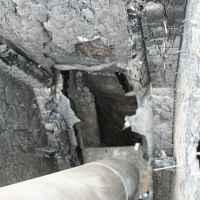On a cold winters night a family is gathered in the living room of their home enjoying the warmth of their fireplace. After using the fireplace all day, they go off to bed to a nice restful sleep. However, they are soon rudely waked by the sound of a smoke alarm in the home. Rushing out into the cold night they can see smoke, but no flame in the home. Outside, they can see that the chase around the fireplace chimney is burning. The fire department is called and thankfully extinguishes the fire before it does widespread damage, however the family must leave the home for several months as repairs are made.
The above scenario happens with some regularity during the winter heating season. According to NFPA statistics, 6% of all residential structure fires involve a chimney or flue. Fireplaces and chimneys are typically of either site built masonry or manufactured metal construction. There are also manufactured masonry fireplaces and chimneys. In either case, a safe installation requires close adherence to codes and standards and, for manufactured systems, close adherence to the manufacturer’s instructions.

Although the exterior of the stone veneer chimney chase looks relatively undamaged, the interior or the chase was badly burned.
For both site built and manufactured construction, NFPA 211 Standard for Chimneys, Fireplaces, Vents, and Solid Fuel-Burning Appliances provides guidance for proper construction. Additionally, the International Residential Code for One and Two Family Dwellings (IRC) has requirements for construction of residential fireplaces and chimneys. The IRC is adopted by law in most locales. These codes contain highly detailed construction requirements for site built systems. They also require that manufactured fireplaces and chimneys be listed and labeled to certain UL standards and installed in accordance with the manufacturer’s instructions. There are a number of UL standards that apply to these systems, most notably UL 127 Factory Built Fireplaces and UL 103 Factory-Built Chimneys for Residential Type and Building Heating Appliances. Other UL standards address chimneys for higher heat appliances.
Warren commonly reviews chimney and fireplace related fire losses for our clients. The technical requirements for these installations are intricate and opportunities for improper construction are substantial.

The interior of this chase and surrounding roof framing was badly burned in a fire. The fire resulted from construction defects in the installation of the chimney system.
Typical problems that we encounter are improper clearance to combustibles, improper selection of manufactured components, not following manufacturer’s instructions and use of unlisted components on a listed system. Additionally, sometimes the chimney has not been cleaned on the required periodic basis. This can cause a fire inside the chimney. However, it should be noted that the codes and standards for chimneys are based on safely containing a moderate chimney fire without spreading the fire to adjacent combustibles if the installation is correctly performed. When a chimney fire spreads to adjacent combustibles, a close examination should be made to ascertain if the construction complies with required codes and standards.
Founded in 1997, The Warren Group, forensic engineers and consultants provides technical investigations and analysis of personal injury and property claims as well as expert testimony for insurance adjusters and attorneys. Extremely well versed in the disciplines of mechanical, electrical, chemical, structural, accident reconstruction and fire and explosion investigation, our engineers and consultants are known for delivering the truth — origin, cause, responsibility and cost of an event or claim — with unmistakable clarity.



